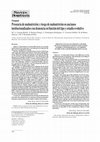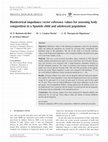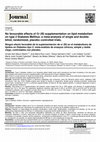Papers by Paz Redondo-del-Río

Nutrients, 2021
Copper is an essential micronutrient for humans. A cross-sectional and comparative study was done... more Copper is an essential micronutrient for humans. A cross-sectional and comparative study was done to assess serum Cu levels and serum copper/zinc (Cu/Zn) ratio and its association with nutritional indicators in a series of children and adolescents with chronic diseases. Anthropometric, biochemical, dietary, body composition, and bone densitometry assessments were carried out. Serum Cu and Zn were measured by atomic absorption spectrophotometry. Seventy-eight patients (55% women) participated. The mean serum Cu in the entire series and by nutritional status through body mass index (BMI) was normal. Serum Cu decreased significantly with age and was meaningfully higher in children than in adolescents. The risk of finding altered Cu levels in children and men was higher than in adolescents and women, respectively. Twenty-two per cent of patients had abnormal serum copper levels, 13 had hypercupremia, and four had hypocupremia. The Cu/Zn ratio was greater than 1.00 for 87% of the patient...
Universidad de Valladolid, 2000

Objective: To determine if there exist differences in the nutritional status of patients with dem... more Objective: To determine if there exist differences in the nutritional status of patients with dementia according to the type and severity of the disease. Method: In this cross-sectional study we carried out an assessment of the nutritional status (anthropometrical assessment, Mini Nutritional Assessment, Chang’s protocol) in 83 institutionalized elderly diagnosed with dementia at evolutionary states of 5, 6, and 7 of GDS (Global Deterioration Scale) and FAST (Functional Assessment Stating). The results were analyzed by the Chi-squared, ANOVA, or Kruskal-Wallis tests, the Scheffe’s posteriori contrasts, and the linear trend test. Significance was considered at p < 0.05. Results: The mean age of the patients was 81.22 years. The BMI revealed that 21% of the sample were at risk for malnourishment and 14.5% were malnourished. However, by using the MNA, 56.6% of the patients were at risk for malnourishment and 41% were malnourished. According to the Chang's method, the percentage ...
Tratamiento nutricional: de la investigación a la gestión, 2002, ISBN 84-7885-298-0, págs. 97-117, 2002
Nutricion Hospitalaria, 1998
... Evaluación nutricional y análisis de la ingesta en un grupo de gimansia rítmica. Autores: MJ ... more ... Evaluación nutricional y análisis de la ingesta en un grupo de gimansia rítmica. Autores: MJ Castro, MP Redondo, Margarita Alonso Franch; Localización: Nutrición hospitalaria: Organo oficial de la Sociedad española de nutrición parenteral y enteral, ISSN 0212-1611, Vol. ...

American Journal of Human Biology, 2017
Objectives: Reference values of the bioelectrical impedance vector for the Spanish child and adol... more Objectives: Reference values of the bioelectrical impedance vector for the Spanish child and adolescent population are needed for assessing body composition and hydration status in this population. The aim of this study is to provide reference values of the bioelectrical impedance vector in Spanish children and adolescents aged 4-18 years from Castilla y Le on. Methods: This was a cross-sectional descriptive study conducted in 4401 Spanish healthy children and adolescents aged 4-18 years (2265 boys and 2136 girls). Resistance and reactance were measured with a single-frequency impedance analyzer at 50 kHz (tetrapolar analysis). The values of resistance and reactance normalized by height were used to plot the bivariate 50th, 75th, and 95th percentiles of the population by age group. Mean impedance vectors were compared with Hotelling's T 2 test for vector analysis (differences being considered significant if p < .05). Results: Tolerance ellipses were drawn for the Spanish child and adolescent population studied. The mean impedance vector showed displacement across all age groups except for (1) girls aged 12-13 years, (2) girls aged 15-18 years, and (3) boys aged 16-18 years. There were sex-related differences in the mean impedance vector in all age ranges, even in prepubertal children. Among adolescents, the patterns of the vector displacement were consistent with the timing of normal growth and development in all groups and are attributable to the maturation process. Conclusions: New tolerance ellipses have been constructed for Spanish children and adolescents by sex and age. These ellipses reflect the timing of normal childhood growth and development.

Nutrición Hospitalaria, 2016
La anorexia nerviosa (AN) es el trastorno del comportamiento alimentario más prevalente en niños ... more La anorexia nerviosa (AN) es el trastorno del comportamiento alimentario más prevalente en niños y adolescentes; su tratamiento es largo ycomplejo, e involucra a múltiples profesionales. La rehabilitación nutricional y la recuperación de un peso corporal normal es uno de los objetivoscentrales en las fases iniciales del tratamiento del paciente ingresado. Sin embargo, las recomendaciones actuales sobre los requerimientosenergéticos iniciales para estos pacientes son inconsistentes, con una clara ausencia de estudios controlados, evidencia científi ca disponible yconsenso global sobre la forma de realimentación más efectiva y segura en adolescentes ingresados con anorexia nerviosa (AN). Clásicamentese han recomendado una realimentación conservadora para prevenir el síndrome de realimentación. No obstante, han aparecido recientementevarios trabajos recomendado una ingesta calórica inicial más elevada, sin observar más complicaciones ni síndrome de realimentación, y asociadasa estancia...
Ans Alimentacion Nutricion Y Salud, 2006
Revista española de …, 2009
Acceso de usuarios registrados. Acceso de usuarios registrados Usuario Contraseña. ...
Nutrición …, 1998
... | Ayuda. Bioimpedancia : comparación de medidas con tres aparatos distintos. Autores: MPRedon... more ... | Ayuda. Bioimpedancia : comparación de medidas con tres aparatos distintos. Autores: MPRedondo, MJ Castro, Margarita Alonso Franch; Localización: Nutrición hospitalaria: Organo oficial de la Sociedad española de nutrición parenteral y enteral, ISSN 0212-1611, Vol. ...

Introduction. Type 2 diabetes mellitus is an important global health issue which prevalence has b... more Introduction. Type 2 diabetes mellitus is an important global health issue which prevalence has been increasing in the last years. Many studies have linked chromium supplementation with improvement of type 2 diabetes mellitus. Aim. Perform a meta-analysis of single and double-blind, randomized, placebo controlled trials, where participants diagnosed of type 2 DM or glucose intolerants were supplemented with Cr (III). Methods. Systematic literature search in electronic databases was conducted, using the following search terms: (diabetes) AND (chromium), until July, 2016. Eligible studies were limited to double or single-blind, parallel group, placebo-controlled, randomized clinical trials, comparing Cr mono or combined supplementation at least for 30 days against placebo, in subjects diagnosed of type 2 DM or with glucose intolerance. Results. Total doses of Cr supplementation and brewer’s yeast ranged from 20 to 1000 μg/day, and duration of supplementation ranged from 30 to 120 days...

Aging conditions morphological and physiological changes in all body cells, tissues, and organs, ... more Aging conditions morphological and physiological changes in all body cells, tissues, and organs, changes that affect the functioning of all body systems. The main alterations in body composition are fat mass (FM) increases and fat-free mass (FFM) reductions. The FM redistributes from subcutaneous to intraabdominal fat depots, and there is an increasing fat infiltration into nonfat tissues. The composition and content of the FFM also change with aging. Overall, FFM starts decreasing by around the age of 40–50 years, and most of this loss is attributable to a reduction in skeletal muscle and bone mineral density. Bioelectrical impedance analysis and anthropometry are the most common methods used for assessing body composition in clinical practice, but aging-related changes in body composition can affect their validity. Nevertheless, bioelectrical impedance vector analysis is valid for assessing body composition both in healthy and pathologically aged populations.

Nutrients
Cystic fibrosis (CF) patients require a stable and sufficient supply of micronutrients. Since cop... more Cystic fibrosis (CF) patients require a stable and sufficient supply of micronutrients. Since copper is an essential micronutrient for human development, a cross-sectional study was carried out to investigate the serum copper levels, serum copper/zinc (Cu/Zn) ratios, and their relationship with nutritional indicators in a group of CF patients. Anthropometric, biochemical, and dietary measurements, an abdominal ultrasound, and respiratory and pancreatic tests were conducted. Seventeen CF patients were studied (10 females, 59%), 76.5% of whom were ∆F580. Their mean serum copper (113 ± 23 μg/dL) was normal, and there was only one teenager with hypocupremia (6%) and two children with hypercupremia (18%). A significant association between serum copper and zinc levels was discovered. The Cu/Zn ratio was higher than 1.00 for 94% of patients, which is an indicator of an inflammation status. There was no significant correlation between the serum copper concentrations and respiratory and panc...

Nutrients
Background: Zinc is an essential nutrient for all forms of life and its deficiency affects the no... more Background: Zinc is an essential nutrient for all forms of life and its deficiency affects the normal growth and development of human beings. Objective: The main aim was to investigate zinc nutritional status by serum zinc concentration (SZC) and dietary zinc intake and their association in cystic fibrosis (CF) patients. Methods: A cross-sectional study was conducted in CF patients. Anthropometric measurements and respiratory and pancreatic tests were conducted. Hypozincemia was determined by SZC while using atomic absorption spectrophotometry and dietary zinc deficiency by prospective 72-h dietary surveys. Results: Mean SZC (87.2 ± 16.7 μg/dL) and dietary zinc intake (97 ± 26.9% Dietary Reference Intake) were normal. Three of 17 patients with CF (17.6%) had hypozincemia and four (23.5%) had a dietary zinc deficiency. No patient with dietary zinc deficiency had hypozincemia. A positive and significant association was observed between SZC and Z-score of BMI-for-age (p = 0.048) and we...
Journal of Community Health

Experimental Gerontology, 2016
To compare body composition as assessed by conventional and vector bioelectrical impedance analys... more To compare body composition as assessed by conventional and vector bioelectrical impedance analysis according to the nutritional cataloging using body mass index (BMI) in a group of institutionalized elderly. Cross-sectional study in 38 institutionalized elderly. Body composition was estimated by bioimpedance analysis. Differences in body composition were analyzed using t-test and ANOVA, or their corresponding nonparametric tests. Statistical significance was set at p&lt;0.05. Based on BMI, the sample showed overweight (average BMI: 26.4kg/m), and women had higher BMI values than men (28.9 vs. 25.5kg/m). Based on waist circumference, abdominal obesity was detected in 60.7% of men and 80% of women. Conventional bioimpedance analysis (BIA) yielded high fat mass values and slightly depleted skeletal muscle mass, compatible with sarcopenic obesity. All individual impedance vectors were located on the right of the major axis of the tolerance ellipses, reflecting body-cell-mass depletion in all subjects, regardless of BMI cataloging. Bioelectrical impedance vector analysis (BIVA) detects body compartment changes in institutionalized elderly that are not identified by the most widely used clinical practice nutritional indicators, such as BMI, waist circumference, and BIA-estimated body composition.
Nutrición Hospitalaria, 2016
-

Nutrición Hospitalaria, 2016
Introducción: el cromo es un oligoelemento esencial para el metabolismo de carbohidratos y lípido... more Introducción: el cromo es un oligoelemento esencial para el metabolismo de carbohidratos y lípidos, que actualmente está prescrito para controlar la diabetes mellitus. Los resultados de las revisiones sistemáticas anteriores y metaanálisis de los suplementos de cromo y de perfiles metabólicos en diabetes han sido inconsistentes.Objetivo: el objetivo de este metaanálisis fue evaluar los efectos sobre los perfiles y la seguridad de la suplementación de cromo en la diabetes mellitus tipo 2 y el colesterol.Métodos: se realizaron búsquedas bibliográficas en PubMed, Scopus y Web of Science mediante el uso de palabras clave relacionadas y ensayos clínicos aleatorios durante el período de 2000-2014.Resultados: trece ensayos cumplieron los criterios de inclusión y se incluyeron en esta revisión sistemática. Las dosis totales de la suplementación con Cr y levadura de cerveza oscilaron desde 42 hasta 1.000 mg/día, y la duración de la suplementación varió de 30 a 120 días. El análisis indicó qu...

Uploads
Papers by Paz Redondo-del-Río